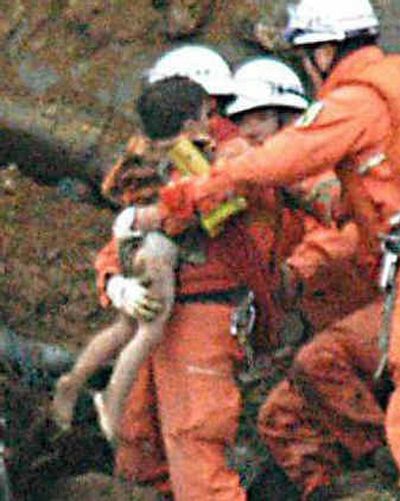Discovery of body dashes hopes for earthquake victim

TOKYO – A 3-year-old girl buried in the rubble of an earthquake-triggered landslide in northern Japan was found dead today , a day after rescuers pulled her younger brother alive from the wreckage.
Workers were still struggling to free Mayu Minagawa’s body from the car where she, her mother and her brother were buried in Saturday’s 6.8-magnitude earthquake, said Tetsuya Hasebe of the Niigata Prefectural government.
The death brought the toll in Saturday’s quake to 33.
Workers rescued 2-year-old Yuta on Wednesday in a dramatic rescue broadcast live on national television. Shortly afterward they retrieved Takako Minagawa, 39, from the driver’s seat but she was declared dead at a hospital.
Officials said the impact of the crash killed her almost immediately.
The team worked through the night to reach Mayu in hopes of finding her alive, but were having trouble early today because she was deeply lodged inside the van, which lay at a steep incline, officials said.
An unidentified rescue crew member told public broadcaster NHK that the boulders virtually demolished the van, adding that workers had to move slowly because there was a risk that removing rocks might set off a mini-landslide.
The outlook for Mayu’s survival had looked grim.
On Tuesday, Japanese media cited disaster officials saying heat-sensitive sensors were unable to detect her body and she hadn’t responded to their calls. Kyodo News reported that rescuers had spotted her body in the car but that it showed no vital signs, such as a pulse.
Yuta happened to find a three-foot-tall opening under the boulders where he kept relatively warm for four days, even in the late October chill.
Officials at Nagaoka Red Cross Hospital later said the boy was suffering from dehydration, hypothermia and a large gash on his head, but was in stable condition. NHK public broadcaster quoted the toddler telling his father that he drank milk in the car, and he asked for melons and water at the hospital.
The rescue effort captivated Japan, feeding the country with hopeful news after Saturday’s quake, which also injured over 2,000. Earthquake survivors camped out in temporary shelters gathered around television sets, watching crew members pull Yuta and his mother out from under the boulders.
The rescue effort was hobbled by continuing aftershocks, including a magnitude 6.1 jolt Wednesday morning that triggered even more landslides across Niigata, a largely rural area some 160 miles north of Tokyo.
In the four days since Saturday’s quake, the Meteorological Agency recorded 526 aftershocks strong enough for people to feel.
Agency official Masahiro Yamamoto warned that a magnitude-6 aftershock could hit the area within three days, urging residents to take caution and stay away from damaged buildings.
About 100,000 residents remain in public shelters amid fears the aftershocks could trigger more landslides. Thousands more camped out in tents and cars, too afraid to return home.